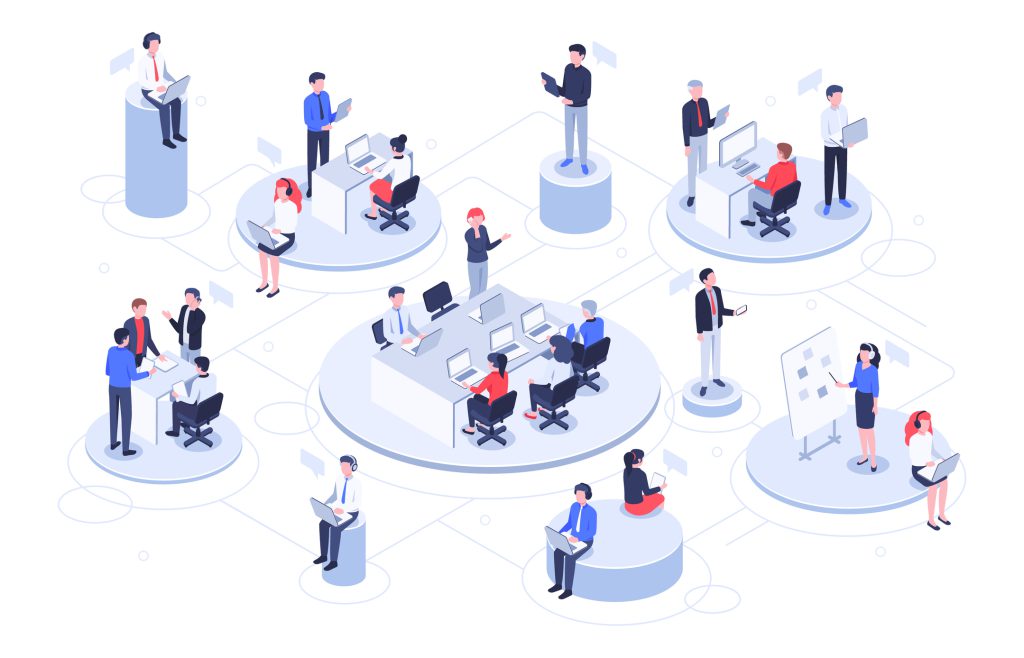Modern PgM, in contrast, has evolved significantly, moving away from rigid structures to embrace more adaptive and responsive methodologies. The fast-paced and ever-changing nature of technology and market demands drives this evolution. Modern PgM focuses on agility, the ability to move quickly and easily, and flexibility, which involves adapting to new, different, or changing requirements.
A key component of this innovative approach is customer-centricity, which places the needs and experiences of the customer at the core of program management. By prioritizing these elements, modern PgM approaches are better suited to handle the complexities and rapid changes commonly encountered in today’s IT initiatives. Therefore, in this article, we will explore how these approaches look and the most essential characteristics of modern program management in IT.
Traditionally, program management (PgM) in Information Technology (IT) was characterized by a rigid, linear approach, known as the “waterfall” model. This methodology emphasized thorough planning, sequential design, and strict phase-by-phase execution, where each phase had to be completed before the next could begin. This approach, while methodical and predictable, often led to challenges in accommodating changes once a project was underway. With a heavy emphasis on documentation and adherence to initial plans, traditional PgM struggled to adapt to the latest information or evolving requirements, often resulting in overruns in both time and budget when modifications became necessary.
Embracing Agile in IT PgM
Agility in IT PgM is about the capacity to adapt rapidly and efficiently to change. It’s a departure from the traditional belief that following a set plan strictly is the key to success. Instead, agility focuses on recognizing that requirements may evolve and that responding to these changes promptly is crucial. Agile PgM values
- adaptive planning,
- evolutionary development and frequent release of outputs,
- prompt delivery of outcomes, and
- continuous improvement.
It emphasizes a flexible approach to project management, which allows for frequent reassessment of ongoing work, making it possible to align the deliverables more closely with user needs and evolving market realities.
Implementing Agile Methodologies in Practice
Incorporating agile methodologies into IT PgM involves more than just adopting a new set of practices; it requires a cultural shift within the organization. This shift includes embracing frameworks like Scrum, Kanban, or Lean, which break down the program into smaller, more manageable segments, or “sprints/iterations” These frameworks promote working in short, iterative cycles and emphasize the delivery of functional modules at the end of each cycle.
The practical application of these methodologies involves:
- Constant collaboration among team members and stakeholders.
- Regular retrospectives for continuous improvement.
- Maintaining a product backlog that is continually updated based on stakeholder feedback and changing market conditions.
Understanding Customer-Centricity in IT PgM
Customer-centricity in IT PgM revolves around understanding and addressing the specific needs and expectations of the customer. This approach requires a deep understanding of the customer’s business environment, challenges they face, and their strategic goals. By aligning the program’s objectives with the customer’s requirements, PgM ensures that the solutions delivered are not only technically sound but also provide tangible business value. This focus shifts the priority from merely completing tasks to delivering outcomes that are meaningful and beneficial to the customer.
Effective Requirements Management
Adopting a customer-centric approach necessitates a dynamic and flexible method for managing requirements. Unlike traditional models, where requirements were determined at the outset and remained fixed, modern PgM practices involve continuous engagement with the customer to refine and adjust requirements as the program progresses. This approach may include various techniques such as user story mapping, regular customer feedback sessions, and iterative prototyping. The goal is to remain responsive to the customer’s evolving needs, thereby ensuring that the final deliverables are aligned with what is required.
Driving Program Objectives with Customer Needs
In customer centric PgM, the customer’s evolving needs and feedback are the primary drivers of the program’s objectives and outcomes. This approach ensures that the program remains relevant and valuable to the customer throughout its lifecycle. Programs managed in this way are more likely to result in products or services that accurately meet the customer’s needs, leading to higher customer satisfaction and loyalty. This strategy requires an ongoing dialogue with the customer, a deep understanding of their business, and the flexibility to adjust the program’s direction based on this evolving understanding.
Examples of Customer-Centric Strategies
Examples of customer-centric strategies in action include creating joint development teams with the customer, holding regular review meetings to gather feedback, and employing user experience research to understand customer behavior and preferences. These strategies help ensure that the program is continuously aligned with the customer’s expectations and that any adjustments needed to meet these expectations can be made promptly.
Iterative Methodologies in Modern PgM
The Significance of Iterative Methodologies
Iterative methodologies are central to modern PgM, as they allow for incremental development and delivery. This approach, as outlined in frameworks like “Managing Successful Programs (MSP)” by Axelos, involves breaking down the overall program into smaller, more manageable parts, each with its own set of objectives and deliverables. This subdivision allows for frequent reassessments and adjustments, making the program more adaptable to change. It also enables earlier delivery of parts of the program, providing early benefits and allowing for real-world testing and feedback.
Contributing to Program Success
The iterative approach plays a significant role in contributing to the overall success of the program. By dividing the program into smaller projects, each project can be managed more effectively, with a clear focus on its specific objectives. This division allows for lessons learned in one phase to be applied to later phases, enhancing the overall quality and effectiveness of the program. It also helps in managing risks more effectively, as issues can be identified and addressed in earlier stages, reducing their impact on the entire program.
Benefits and Challenges
The adoption of iterative methodologies brings numerous benefits, including increased adaptability to change, improved stakeholder engagement, and more effective risk management. It allows for more frequent reassessment of the program’s direction and objectives, ensuring alignment with business goals and market needs. However, this approach also comes with challenges such as maintaining a coherent vision across different projects, managing dependencies between various parts of the program, and ensuring that the cumulative effect of incremental changes aligns with the overall program objectives.
Continuous Improvement and Adaptability
Role of Continuous Improvement
Continuous improvement in PgM is a key factor in maintaining relevance and effectiveness over time. It involves regularly evaluating processes, methods, and outcomes to identify opportunities for enhancement. This concept is often realized through operational excellence within the organization, where teams strive for incremental improvements in their work, processes, and products. Emphasizing continuous improvement ensures that the program remains efficient, effective, and aligned with changing business needs.
Strategies for Adaptability and Learning
Fostering a culture of adaptability and learning is crucial for the success of modern PgM. This includes creating an environment where feedback is encouraged and valued, promoting a mindset of experimentation, and learning from both successes and failures, and providing opportunities for team members to develop new skills and competencies. Encouraging cross-functional collaboration and open communication also helps in sharing knowledge and insights across the program, contributing to a more adaptable and responsive approach.
Conclusion
In summary, modern program management in IT is characterized by a shift from rigid, plan-driven approaches to more dynamic, adaptive methodologies that emphasize customer-centricity, agility, and continuous improvement. By embracing these principles, organizations can better navigate the complexities of today’s fast-paced technological landscape, delivering solutions that are not only technically sound but also closely aligned with customer needs and business objectives.

